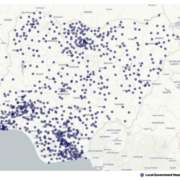For some five years, US policymakers took pains to ensure US leadership in a global 5G race, including flexible use licenses for 5G in multiple spectrum bands like C-band and others. 5G was launched in 2019 and has been deployed quickly in the US.
5G in the C-band was set to launch December 5, 2021, following extensive testing, preparation, and experience of wireless service rollout by the Federal Communications Commission (FCC). Transmission rules for the C-band were published in March 2020. At the 11th hour, the Federal Aviation Administration (FAA) issued a cryptic safety alert, saying that while there is no evidence that 5G harms the operation of altimeters, that pilots should pay attention to their gauges. Ostensibly, the FAA is concerned about interference to outdated altimeters on old planes and helicopters but lacking technical or regulatory standards for altimeters, it appears the FAA has only limited idea of where these obsolete altimeters are and how many are there. Despite its acknowledged lack of information, the FAA boasts that US airspace is the most complex in the world and its safety; the best. With more than 40 nations having rolled out 5G on some 200 networks without problems to aviation, the situation with the FAA has become a national embarrassment.
Why did this happen?
The telecom regulator FCC has managed interference for safety and coexistence for over 80 years and has addressed these issues before. The FAA and FCC typically cooperate on the rollout of wireless technologies (think 3G, 4G etc.). Now it’s different.
The FAA has based this entire dispute on a theoretical modeling of multiple worst-case scenarios with obsolete altimeters, not testing with the actual equipment used in modern aircraft or 5G networks. In fact the FAA attests that it has no evidence of actual interference. The truth can be independently verified, but FAA chose not to do this. Instead the FAA has colluded with various aviation trade associations (pilots, airlines, and aircraft) in the hope that they can get the mobile industry to cough up $100 million or so to pay for altimeter upgrades. Additionally 5G offers a potent opportunity for the FAA to distract public attention from airlines’ poor performance and many regulatory shortcomings. And the FAA has no qualms about bogus safety alerts to scare the public if it fulfills its larger goal: to maintain meaning and tribute from the aviation industry.
Do other countries have this problem?
France, among more than 40 nations, does not have this problem at all. Compared to the US, France has use reason, science, and evidence to test the proposition that 5G transmissions interfere with altimeters. When the theoretical study was published in October 2020, France’s National Frequency Agency (ANFR) took it seriously. It convened the relevant parties: French Civil Aviation Authority (DGAC), Arcep the telecom regulator, and industry, including aircraft maker Airbus. They set up a testing plan, performed tests, and subsequently developed mitigation at airports. They were able to keep the 5G rollout on schedule. In France, these government agencies realize that they must work together for the good of the people. They recognize that aviation safety and 5G can and should exist together.
ANFR solved in weeks what has taken the FAA months – and the FAA seems to want to pause 5G indefinitely.
What’s the situation in Japan?
Japan is an interesting case because part of its 5G operation (3.6–4.2 MHz) overlays altimeters (4.0-4.2 MHz). And yet the Japanese report no problems to aviation. There are tens of thousands of base stations deployed in Japan, and networks are arguably even more dense than in the US. Japan has even less mitigation at airports than the US proposes. Like the US, Japan prides itself on technological leadership, and its innovative industries in electronics, communications, software, entertainment, and automotive depend on next generation networks like 5G. So the Japanese have solved their problem, or rather, they do not allow a fake problem to take root.
How does one explain what is happening in the US?
There is breakdown of leadership the US federal government. Regulatory agencies have lost sight of their mission to serve the people, and they are captured by industry, particularly the FAA, which is beholden to the trade associations for pilots, airlines, and aircraft. Airbus is an example of a company which has made two different messages. In France, Airbus is supportive of 5G. But in US, they have publicly stated the 5G in the C-band in a problem. This is not logical. The physics of 5G works the same everywhere on planet earth.
RELATED 2022 Predictions On Cybersecurity, 5G, Cloud And More – By Strand Consult
This problem could be solved immediately by the US President, but there is a lack of leadership. The agencies and political parties are compromised by corporate interests. Sadly the American people lose. For one, they receive false safety information from the FAA. Secondly, people are deprived of 5G in the C-band, which is ultra-fast wireless broadband. That includes foreigners who travel to the US who can’t use their 5G phone functionality in the C-band when they come to the US.
How have US 5G providers responded?
In addition to existing rules for interference and a giant spectrum guard band between 5G and altimeters, US operators have voluntary adopted the most stringent transmission conditions around airports of any country in the world. This includes lowering power levels and shifting the direction of transmission. These conditions were accepted by US authorities some weeks ago. Then the aviation industry, still looking for a payout to upgrade their altimeters, increased pressure, and the FAA caved and reneged on its earlier agreement.
The technical explanation: 5G, the C-band, and altimeters
5G, or 5th generation, is the current generation of mobile wireless broadband. It’s a high-speed broadband service delivered through the air, rather than by wire. The standards of 5G are developed through a professional global organization called the Third Generation Partnership or 3GPP. 5G is disruptive to traditional wireline sources of broadband like DSL, cable and fiber. 5G is an important technology that creates competition in the broadband marketplace because it is more economical to deploy than wireline technologies.
The C-band refers to a set of radio frequencies between 3.7 and 4.2 GHz. C-band is harmonized globally for 5G because it has physical properties well-suited for broadband, including the ability to transmit large amounts of data across long-distances. While North American, Asian, and European spectrum bands don’t match up exactly, there is overlap such that the physical properties are the same. To compensate, the US adopted a 220 MHz guard band around the operation of altimeters, twice the request of the aviation industry, which ensure the transmission of 5G and altimeters don’t interfere. Economists and spectrum experts have observed that the guard band, as large as the C-band space licensed for 5G, is excessive. Moreover, it represents a dead weight loss to society, as the frequency would otherwise be licensed, bringing tens of trillions of dollars of revenue to the Treasury. The further injustice is that a handful of atavistic altimeter actors are prioritized over of some 300 million Americans who want more broadband.
An altimeter is a gauge on aircraft used to measure distance to the ground. Unlike providers of 5G phones and infrastructure, the makers of altimeters do not engage in a global standards process. While modern planes have multiple modern altimeters, old aircraft still have old altimeters. US regulators have not regulated altimeters because it adds additional cost to aviation, though minimal in the scheme of things. This entire situation would have been avoided if makers of altimeters professionalized their product development with technical standards.
Has FAA and the aviation industry been asleep at the cockpit for years?
It is suspicious that the FAA’s made an 11th hour announcement about what it purports to be a serious safety issue with no actual evidence. The subsequent piling on by aviation actors just as mitigation is agreed is also less than authentic. What is particularly galling is how the same aircraft maker can bless C-band 5G in 40 countries and suddenly claim that there is a problem in the US.
The Boeing 737 Max disaster in 2020, the result of FAA outsourcing of safety oversight (and associated coverup of whistleblowers), is not far from people’s minds. It cost Boeing’s CEO his job and $60 billion to Boeing shareholders. It does not take much to conjure fear of a falling plane. A Senate report detailed FAA failings which led to the disaster, but it’s not clear whether these issues have been resolved. They include FAA senior managers not being held accountable for failure to develop and deliver adequate training in flight standards for decades; FAA retaliation against whistleblowers, failure of the Department of Transportation Office of General Counsel to conduct internet reviews and to produce relevant documents requested by Congress.
The FAA and the aviation industry have known about 5G in the C-band for years but said and did little to nothing to indicate there was a problem. If 5G was a legitimate safety issue, aviation actors would have acted sooner to prevent deployment in the US and around the world. Instead, the FAA and the aviation industry sensed an opportunity. By waiting until the last moment, they could exploit the situation to their advantage. Further this behavior fits with the FAA’s pattern of outsourcing regulation and symbolic safety posturing, rather than the pursuit of legitimate safety.
There’s a term for what the FAA and the aviation industry is doing: blackmail. It is a criminal offense, but “independent” regulators like the FAA with limited Congressional or White House oversight can get away with it. In the process, the FAA gives its regulated industries cover.
Please contact Strand Consult, if you are interested in our knowledge about this sucject.





























